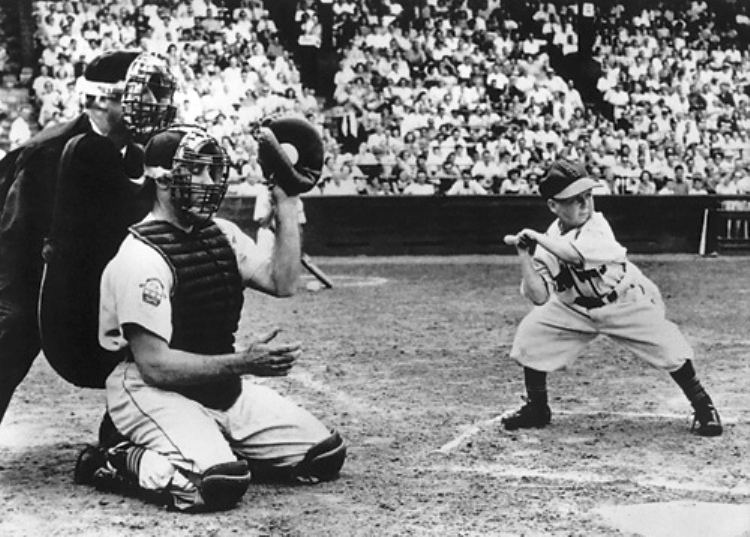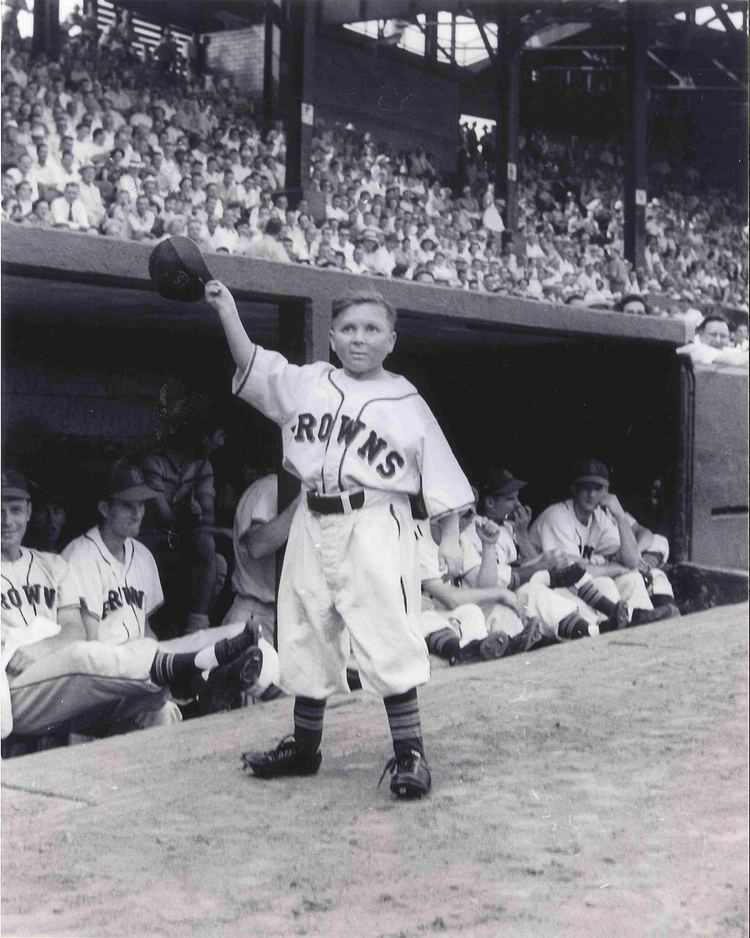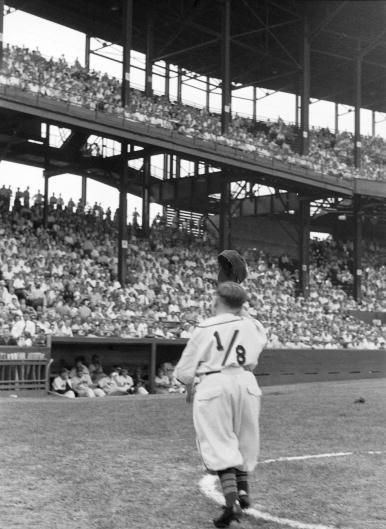On-base percentage 1.000 Name Eddie Gaedel Batting average – Role Baseball player | Plate appearances 1 Height 1.09 m Base on balls 1 | |
 | ||
The biggest man in baseball eddie gaedel documentary
Edward Carl Gaedel (June 8, 1925 – June 18, 1961) was an American with dwarfism who became famous for participating in a Major League Baseball game.
Contents
- The biggest man in baseball eddie gaedel documentary
- Shortest major league baseball player ever eddie gaedel
- Appearance
- At the plate
- Baseball reaction
- Later life
- Death
- Legacy
- Kyle Gaedele
- References

Gaedel (some sources say the family name may actually have been Gaedele) gained recognition in the second game of a St. Louis Browns doubleheader on August 19, 1951. Weighing 65 pounds (29 kg) and standing 3 feet 7 inches (1.09 m) tall, he became the shortest player in the history of the Major Leagues. Gaedel made a single plate appearance and was walked with four consecutive balls before being replaced by a pinch-runner at first base. His jersey, bearing the uniform number " 1⁄8", is displayed in the St. Louis Cardinals Baseball Hall of Fame and Museum.

St. Louis Browns owner Bill Veeck, in his 1962 autobiography Veeck – As in Wreck, said of Gaedel, "He was, by golly, the best darn midget who ever played big-league ball. He was also the only one."

Shortest major league baseball player ever eddie gaedel
Appearance

Due to his size, Gaedel had worked as a riveter during World War II, and was able to crawl inside the wings of airplanes. He was a professional performer, belonging to the American Guild of Variety Artists (AGVA). After the war, Gaedel was hired in 1946 by Mercury Records as a mascot to portray the "Mercury Man." He sported a winged hat similar to the record label's logo, to promote Mercury recordings. Some early Mercury recordings featured a caricature of him as its logo.
Browns' owner Bill Veeck, a showman who enjoyed staging publicity stunts, found Gaedel through a booking agency. Secretly signed by the Browns, he was added to the team roster and put in uniform (with the number "1/8" on the back). The uniform was that of current St. Louis Cardinals managing partner and chairman William DeWitt, Jr. who was a 9-year-old batboy for the Browns at the time.
Gaedel came out of a papier-mache cake between games of a doubleheader at Sportsman's Park in St. Louis to celebrate the American League's 50th anniversary. The stunt was also billed as a Falstaff Brewery promotion. Falstaff, and the fans, had been promised a "festival of surprises" by Veeck. Before the second game got underway, the press agreed that the "midget-in-a-cake" appearance had not been up to Veeck's usual promotional standard. Falstaff personnel, who had been promised national publicity for their participation, were particularly dissatisfied. Keeping the surprise he had in store for the second game to himself, Veeck just meekly apologized.
Although Veeck denied the stunt was directly inspired by it, the appearance of Gaedel was unmistakably similar to the plot of "You Could Look It Up," a 1941 short story by James Thurber. Veeck later insisted he got the idea from listening to the conversations of Giants manager John McGraw decades earlier when Veeck was a child.
At the plate
Gaedel entered the second half of the doubleheader between the Browns and Detroit Tigers in the bottom of the first inning as a pinch-hitter for leadoff batter Frank Saucier. Immediately, umpire Ed Hurley called for Browns manager Zack Taylor. Veeck and Taylor had the foresight to have a copy of Gaedel's contract on hand, as well as a copy of the Browns' active roster, which had room for Gaedel's addition.
The contract had been filed late in the day on Friday, August 17. Veeck knew the league office would summarily approve the contract upon receipt, and that it would not be scrutinized until Monday, August 20. Upon reading the contract, Hurley motioned for Gaedel to take his place in the batter's box. (As a result of Gaedel's appearance, all contracts must now be approved by the Commissioner of Baseball before a player can appear in a game.) The change to that day's St. Louis Browns scorecard, listing Gaedel and his uniform number, had gone unnoticed by everyone except Harry Mitauer, a writer for the St. Louis Globe-Democrat. The Browns' publicity man shunted Mitauer's inquiry aside.
Gaedel was under strict orders not to attempt to move the bat off his shoulder. When Veeck got the impression that Gaedel might be tempted to swing at a pitch, the owner warned Gaedel that he had taken out a $1 million insurance policy on his life, and that he would be standing on the roof of the stadium with a rifle prepared to kill Gaedel if he even looked like he was going to swing. Veeck had carefully trained Gaedel to assume a tight crouch at the plate; he had measured Gaedel's strike zone in that stance and claimed it was just one and a half inches high. However, when Gaedel came to the plate, he abandoned the crouch he had been taught for a pose that Veeck described as "a fair approximation of Joe DiMaggio's classic style," leading Veeck to fear he was going to swing. (In the Thurber story, the player with dwarfism cannot resist swinging at a 3-0 pitch, grounds out, and the team loses the game).
With Bob Cain on the mound - laughing at the absurdity that he actually had to pitch to Gaedel - and catcher Bob Swift catching on his knees, Gaedel took his stance. The Tigers catcher offered his pitcher a piece of strategy: "Keep it low." Cain delivered four consecutive balls, all high (the first two pitches were legitimate attempts at strikes; the last two were half-speed tosses). Gaedel took his base (stopping twice during his trot to bow to the crowd) and was replaced by pinch-runner Jim Delsing. The 18,369 fans gave Gaedel a standing ovation.
Baseball reaction
Veeck had hoped that Delsing would go on to score in a one-run Browns victory, but he ended up stranded at third base and the Tigers went on to win the game 6–2. American League president Will Harridge, saying Veeck was making a mockery of the game, voided Gaedel's contract the next day. In response, Veeck threatened to request an official ruling on whether Yankees shortstop and reigning MVP Phil Rizzuto was a short ballplayer or a tall dwarf.
Initially, Major League Baseball struck Gaedel from its record book, as if he had not been in the game. He was relisted a year later, as a right-handed batter and left-handed thrower (although he did not play the field). Eddie Gaedel finished his major league career with an on-base percentage of 1.000. His total earnings as a pro athlete were $100, the scale price for an AGVA appearance. However, he was able to parlay his baseball fame into more than $17,000 by appearing on several television shows.
Later life
Gaedel's major league career lasted just the one plate appearance, but Veeck continued to employ Gaedel in non-playing promotions over the years: in 1959, Gaedel and three other dwarfs dressed as spacemen were seen presenting "ray guns" to White Sox players Nellie Fox and Luis Aparicio at Comiskey Park. (Gaedel reportedly said, "I don't want to be taken to your leader. I've already met him.") In 1961, Veeck (who by that time had become owner of the White Sox) hired several dwarfs and midgets, including Gaedel, as vendors, so as not to "block the fans' view" of the game.
Death
On June 18, 1961, the unemployed Gaedel, who had just turned 36, was at a bowling alley in Chicago, his birthplace and hometown. Gaedel was followed home and beaten. His mother discovered Eddie lying dead in his bed. He had bruises about his knees and on the left side of his face. A coroner's inquest determined that he also had suffered a heart attack. Bob Cain, who'd pitched to Gaedel, was the only Major League Baseball figure to attend the funeral. Gaedel was interred at Saint Mary Catholic Cemetery and Mausoleum in Cook County, Illinois (plot: section G, gravestone number X-363B).
Legacy
Gaedel is one of only five Major League players who drew a walk in their only plate appearance and never played the field. The first three all played in the 1910s: Dutch Schirick (Sep 17, 1914 with the Browns), Bill Batsch (Sep 9, 1916 with Pittsburgh) and Joe Cobb (April 25, 1918 with Detroit; although recent research shows that Cobb may have actually struck out in his only plate appearance). On June 24, 2007, Kevin Melillo of the Oakland Athletics, became the first player in over half a century to walk in his only plate appearance without taking the field, against the New York Mets. Other than Gaedel, the other four players pinch-hit for pitchers; all five appeared in games their teams ultimately lost.
Gaedel's one-day career has been the subject of programs on ESPN and the Baseball Network. He was mentioned by name in the lyrics of Terry Cashman's homage to 1950s baseball, "Talkin' Baseball (Willie, Mickey, and the Duke)." His at-bat was the No. 1 choice on a 1999 list of "Unusual and Unforgettable Moments" in baseball history published by the Sporting News.
In 1994, Veeck's son Mike Veeck owned the minor league St. Paul Saints team. He brought the then 69-year-old Bob Cain to the park to "reenact" the at-bat, by pitching to the 10-year-old son of the Saints manager.
Due to its scarcity, Gaedel's autograph now sells for more than Babe Ruth's.
The song "St Louis Browns" by Skip Battin erroneously adds 16 inches to his height, saying, "he stood about 4-foot-11".
Kyle Gaedele
Gaedel's grandnephew Kyle Gaedele is also a ballplayer, drafted in the 32nd round by the Tampa Bay Rays in 2008 out of high school. The 6-foot-4 Gaedele chose instead to attend Valparaiso University; after hitting .373 as a sophomore in 2010, he was invited to play for the Madison Mallards of the summer collegiate Northwoods League. Kyle led the Mallards in home runs (9) and RBI (38) and went 3-for-4 in the league's All-Star Game. In the June 2011 MLB Draft, the San Diego Padres picked up Gaedele in the sixth round and assigned him to the Eugene Emeralds of the Northwest League. Despite a .203 average in 63 games, the Padres promoted Kyle to the Fort Wayne TinCaps of the Midwest League in 2012, where he hit .258, with 53 walks and 23 stolen bases. In 2013, Gaedele played for the Advanced-A Lake Elsinore Storm, three steps below the majors, and batted .256 with thirteen home runs.
